
Hover flies, also called flower flies or syrphid flies, make up the insect family Syrphidae. As their common name suggests, they are often seen hovering or nectaring at flowers; the adults of many species feed mainly on nectar and pollen, while the larvae (maggots) eat a wide range of foods. In some species, the larvae are saprotrophs, eating decaying plant and animal matter in the soil or in ponds and streams. In other species, the larvae are insectivores and prey on aphids, thrips, and other plant-sucking insects.

Eristalis is a large genus of hoverflies, family Syrphidae, in the order Diptera. Several species are known as drone flies because they bear a resemblance to honeybee drones.

Eristalis tenax, the common drone fly, is a common, migratory, cosmopolitan species of hover fly. It is the most widely distributed syrphid species in the world, and is known from all regions except the Antarctic. It has been introduced into North America and is widely established. It can be found in gardens and fields in Europe and Australia. It has also been found in the Himalayas.

The eastern tailed-blue or eastern tailed blue, also known as Everes comyntas, is a common butterfly of eastern North America. It is a small butterfly that is distinguished from other blues in its range by the small thin tail.
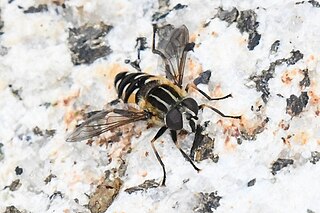
Helophilus groenlandicus, the Black-margined Marsh Fly, is a common species of syrphid fly. Hoverflies can remain nearly motionless in flight. The adults are also known as flower flies for they are commonly found on flowers, from which they get both energy-giving nectar and protein-rich pollen. Though common the larvae of this species like many other Helophilus are not known but the larvae of other species in this genus are associated with wet decaying organic material, particularly accumulations of decaying vegetation in ponds and mud and are a so called rat-tailed type.

Eristalini is a tribe of hoverflies. Several species are well-known honeybee mimics, such as the drone fly Eristalis tenax, while other genera such as Helophilus and Parhelophilus exhibit wasp-like patterns of yellow and black stripes, both strategies to avoid predation by visual predators such as birds.

Satyrium acadica, the Acadian hairstreak, is a butterfly of the family Lycaenidae. It is found in North America from British Columbia east to Nova Scotia and south to Idaho, Colorado, the northern Midwest, Maryland, and New Jersey.
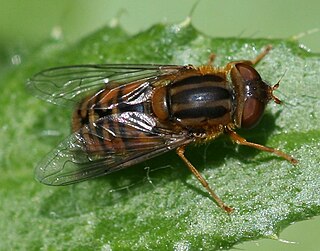
Parhelophilus versicolor is a European hoverfly.
Spilomyia crandalli, Crandall's Hornet Fly, is a rare species of syrphid fly first officially described by Curran in 1951. This species is found in western North America near the Pacific coast. Hoverflies get their names from the ability to remain nearly motionless while in flight. The adults are also known as flower flies for they are commonly found around and on flowers, from which they get both energy-giving nectar and protein-rich pollen. The larvae are known as the short-tailed larvae, suited for moist areas such as rot holes of trees.

Parhelophilus flavifacies , the Black-legged Bog Fly, is a rare species of syrphid fly observed in the Eastern United States and Canada. Hoverflies can remain nearly motionless in flight. The adults are also known as flower flies for they are commonly found on flowers, from which they get both energy-giving nectar and protein-rich pollen. The larvae are the long tailed "rat-tailed" type.
Parhelophilus obsoletus , the Unadorned Bog Fly, is a fairly common species of syrphid fly observed across Canada and the northeastern and central United States. Hoverflies can remain nearly motionless in flight. The adults are also known as flower flies for they are commonly found on flowers, from which they get both energy-giving nectar and protein-rich pollen. The larvae are unknown.
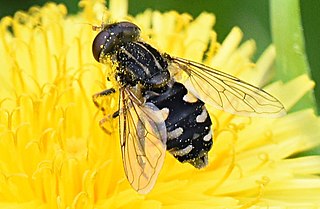
Parhelophilus rex , the Dusky Bog Fly , is a fairly common species of syrphid fly observed in northern North America. Hoverflies can remain nearly motionless in flight. The adults are also known as flower flies for they are commonly found on flowers, from which they get both energy-giving nectar and protein-rich pollen. The larvae are unknown.

Spilomyia liturata, the Rocky Mountain Hornet Fly, is an uncommon species of syrphid fly. This species is found in western North America along the Rocky Mountains. Hoverflies get their names from the ability to remain nearly motionless while in flight. The adults are also known as flower flies for they are commonly found around and on flowers, from which they get both energy-giving nectar and protein-rich pollen. The larvae are known as the short-tailed larvae, suited for moist areas such as rot holes of trees.
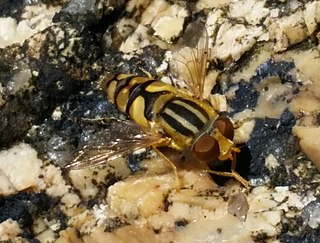
Parhelophilus laetus , the Common Bog Fly , is a common species of syrphid fly observed across norther North America. Hoverflies can remain nearly motionless in flight. The adults are also known as flower flies for they are commonly found on flowers, from which they get both energy-giving nectar and protein-rich pollen. The larvae are unknown.
Brachyopa rufiabdominalis , the Red-tailed Sapeater, is a rare species of syrphid fly. It has been observed in Colorado. Hoverflies get their names from the ability to remain nearly motionless while in flight. The adults are also known as flower flies, for they are commonly found around and on flowers from which they get both energy-giving nectar and protein-rich pollen. Larvae for this genus are of the rat-tailed type. B.rufiabdominalis larvae have not been described.
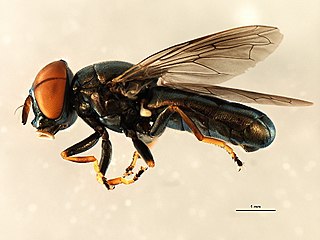
Orthonevra anniae (Sedman, 1966), the shiny-sided mucksucker, is a rare species of syrphid fly. It has been observed in Northeastern North America. Hoverflies get their names from the ability to remain nearly motionless while in flight. The adults are also known as flower flies for they are commonly found around and on flowers, from which they get both energy-giving nectar and protein-rich pollen. Larvae for this genus are of the short tailed rat-tailed type. O. anniae larvae have not been described.

Parhelophilus integer , the shiny bog fly, is a rare species of syrphid fly observed in the Eastern United States. Hoverflies can remain nearly motionless in flight. The adults are also known as flower flies, for they are commonly found on flowers from which they get both energy-giving nectar and protein-rich pollen. The larvae of this genus are the long tailed "rat-tailed" type.
Parhelophilus porcus , the black bog fly, is an uncommon species of syrphid fly observed in Northern North America. Hoverflies can remain nearly motionless in flight. The adults are also known as flower flies for they are commonly found on flowers from which they get both energy-giving nectar and protein-rich pollen. The larvae are the long tailed "rat-tailed" type.
Parhelophilus divisus the yellow-legged bog fly, is a rare species of syrphid fly observed in the northeastern United States. Hoverflies can remain nearly motionless in flight. The adults are also known as flower flies for they are commonly found on flowers, from which they get both energy-giving nectar and protein rich pollen. The larvae are the long tailed "rat-tailed" type.
Total of 245 species either found or highly expected to be found in New York.














